Lately I’ve been having a lot of conversations around investment terms with searchers, as well as investors.
About 15 years ago, I interned at a search fund. And, over the last few years, I’ve started to invest in the asset class going direct as well as through funds of search funds.
Investing in search funds is a great way to scratch my entrepreneurial itch, extremely rewarding when a searcher finds success, and can be economically rewarding too.
This post is my attempt to share thoughts on self funded search economics in an effort to contribute to the search fund community, get feedback on my thinking from a wider audience, and of course meet more people who are doing searches/investing and may want to collaborate (please feel free to reach out!).
You can watch a video of me explaining this model here, and download the excel here:

Enterprise Value
The standard finance equation is enterprise value = debt + stock – cash. Enterprise value is how much the company itself is worth. Many times people confuse it with how much the stock is worth and find the “minus cash” part of this really confusing.
So, you can rearrange this equation to make it stock = enterprise value – debt + cash. Make more sense now?
Enterprise value is just how much you’re willing to pay for the company (future cash flows, intellectual property, etc), not the balance sheet (debt and cash).
Most investors and searchers think about the EBITDA multiple of a company on an enterprise value basis because they’ll be buying it on a cash free, debt free basis. It becomes second nature to think about EBITDA multiples and know where a given business should fall given scale, industry, etc.
However, I believe this second nature way of thinking of things can be a massive disadvantage to investors given the way EV and multiples are talked about in our community currently.
Sources of capital, the typical way to calculate enterprise value for self funded searchers
If you’ve ever looked at or put together a teaser for a self funded search deal, you will notice that the deal value is equal to the sum of the sources of capital minus deal fees and cash to the balance sheet.
As a simple example, if there is $4 mm of debt to fund the deal, $1 mm of equity, and $200k of deal fees, the enterprise value = $4 mm + $1 mm – 200k = $4.8 mm.
We’ll use slightly more complex numbers in our example: If a searcher is taking a $3.2 mm SBA loan, $850k seller note, putting in $120k themselves, getting $350k of equity from the seller, a $500k earnout, and $1.2 mm of equity financing minus $350k to the balance sheet and $250k of deal fees, then the enterprise value will be $5.62 mm.
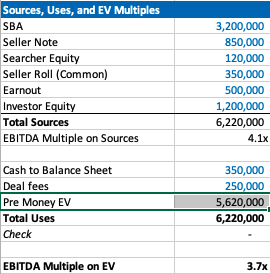
Our example company has $1.5 mm of EBITDA, so the EBITDA multiple is 3.7x. This is a pretty attractive acquisition multiple for a business that meets traditional search criteria (recurring revenues, fragmented competition, high gross margins, low customer concentration, etc).
If you’re seeing a search fund deal for the first time, the headline of “we’re buying a decent company for 3.7x, and replacing a tired owner with a hungry operator” is pretty exciting!
However, if you’re an investor, there is some nuance to this enterprise value number and the true EBITDA multiple you are investing in.
The trick with self funded enterprise value
The security that most self funded search investors get in a deal is participating preferred stock with a paid in kind dividend. This means when there’s an exit, you get your money back before any other equity holder, then get a certain percent of the business, and whatever dividend you’ve been owed in the interim accrues to your principle.
It’s a really favorable security for the investor, and one that is basically impossible to get in VC where straight preferred stock is much more common (no pun intended).
The key terms are what percent of common equity does this security convert into after the originally principal is paid back, and what is the dividend.
The share of common equity the investor group will get typically ranges from 10-50% of the total common stock. The dividend rate is usually 3-15%. The average I’m seeing now is around 30% and 10% for common and dividends respectively.
The strange this about the enterprise value quoted to investors in a teaser/CIM is that it doesn’t change as the percent of common changes, even though this has large implications for how much the common equity is worth and the value investors receive.
For example, I may get a teaser where the sources of investment – cash to balance sheet – deal fees = $3.7 mm for a $1 mm EBITDA company, which would imply a 3.7X EBITDA multiple. Let’s say the searcher is offering investors 30% of the common and a 10% dividend.
Let’s now say that the searcher is having a tough time raising capital and changes their terms to 35% of common and a 12% dividend. Does the effective enterprise value change for investors? I would argue yes, but I would be surprised to see it changed in the CIM/teaser.
This isn’t a knock on searchers or the search fund community. It’s just kind of how things are done, and I think this is mostly because it’s really hard to think about how the enterprise value has changed in this scenario.
However, the natural way of using EBITDA multiples to think about value for a business that is so common in PE/SMB can be extremely misleading for investors here. You may be thinking 3.7X for this type of business is a great deal! But, what if the security you’re buying gets 5% of the common?
If you’re in our world, you may counter this point by saying most searchers will also supply a projected IRR for investors in their CIM. However, IRR is extremely sensitive to growth rate, margin expansion, and terminal value. While the attractiveness of the security will be reflected, it can be greatly overshadowed by lofty expectations.
To get more clarity and have a slightly different mental model on the effective price investors are paying for this business, let’s go back to basics. Enterprise value should be debt + preferred stock + common stock – cash.
We know the values of each of these numbers, except the common. So, the main question here becomes: how much is the common equity worth?
Calculating value of common equity for self funded search funds
Equity value for most search fund deals = preferred equity from investors + the common equity set aside for the searcher and sometimes also advisors, board, seller.
We know that the preferred equity is investing a certain amount for a certain amount of common equity. The rub is that they are also getting a preference that they can take out before any common equity gets proceeds, and they are getting a dividend.
So, the exercise of valuing the common equity comes down to valuing the preference and dividend.
In my mind, there are three approaches:
- The discount rate method where you take the cash flows you’ll get in the future from the pref/dividends and discount them back at the discount rate of your choice. I am using 30% in my model which I believe accurately compensates investors for the risks they are taking in a small, highly leveraged investment run by an unproven operator. If you believe in efficient markets, this number also fits as it mirrors the historical equity returns as reported by the Stanford report, with a slight discount given this asset class has clearly generated excess returns relative to other assets on a risk adjusted basis, hence interest in these opportunities from an expanding universe of investors.
- The second method is to calculate how much money you’d get from your preference and dividends, taking into account that per the Stanford study around 75% of search funds will be able to pay these sums, and then discount these cash flows back at a rate more in line with public equities (7% in my model). This yields a much higher value to the preference/dividend combo, and therefore lowers the implied value of the common equity.
- The last method is to just say nope, there is no value to the preference and dividend. I need them and require them as an investor, but they are a deal breaker for me if they aren’t there, and therefore they don’t exist in my math. This of course makes no logical sense (you need them, but they also have no value?), but I’ve left it in as I think many investors probably actually think this way and it creates a nice upper bound on the enterprise value. Side note, as with obstinate sellers, jerk investors are usually best avoided.
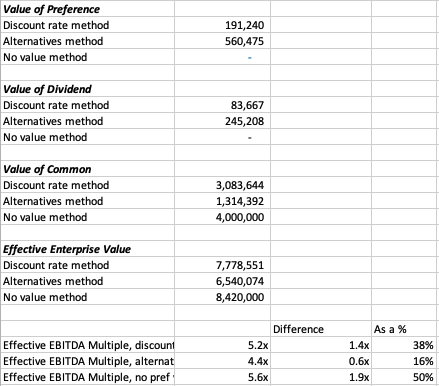
In our example, you can see a breakdown of the preference value, dividend value, and therefore common value and enterprise value for this deal.
In each case, the effective EBITDA multiple moves from 3.7x to something much higher (see the last 3 lines).
There are some simplifying assumptions in the model (no accruing dividend, all paid in last year), and some weird stuff that can happen (if you make the hold time long and the dividend greater than the 7% equity discount rate, the value of the dividend can get really big).
These flaws aside, I think this creates a nice framework to think through what the common is actually worth at close, and therefore what enterprise value investors will be paying in actuality.
It’s worth noting that the whole point of this is to benchmark the value you’re getting relative to market transactions in order to understand where you want to deploy your capital.
This creates a method to translate cash flow or EBITDA multiples of other opportunities on an apples to apples basis (if only there were a magical way to translate the risk associated with each as well!).
Another note, we could calculate the value of the common to be what this asset would trade at market today in a well run auction process minus any obligations (debt, preference, seller financing). However, I think that understates the option value inherent in this equity, a value that is only realized when a new manager takes over with more energy and know how.
There is a finance nerd rational for this. If you plot the value of equity in a leveraged company on a chart, it mirrors the payout of a call option. In both cases, the value of the security increases at a certain inflection point: when the value of equity rises above the strike price in an option, and when the enterprise value of a company rises above the debt level in a levered company.
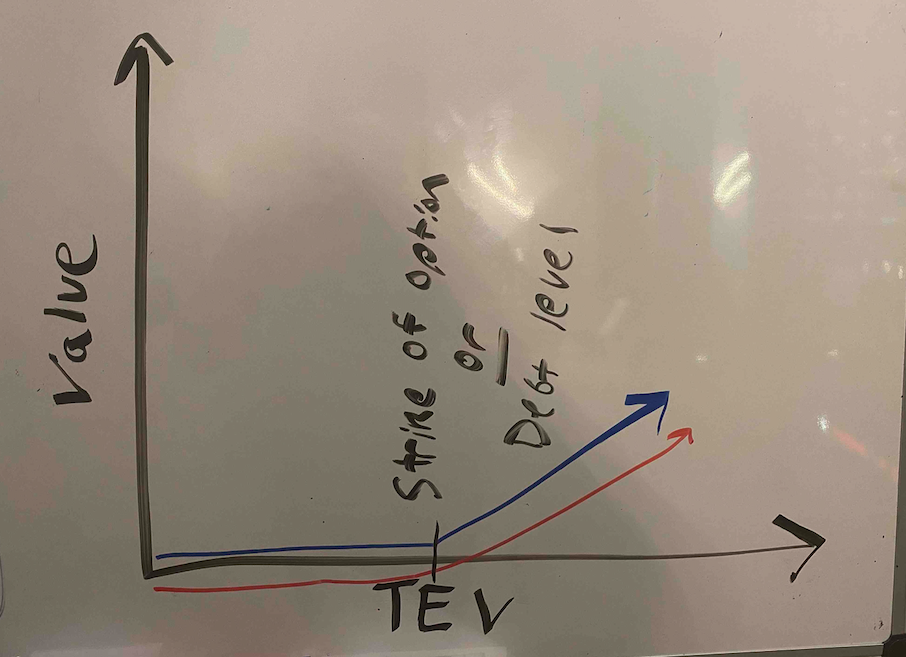
The common equity of a highly levered company can therefore be valued by a similar methodology as the call option: Black Scholes. If you remember back to finance class, increasing volatility will increase the value of an option.
In the search fund case, we’ve (hopefully) increased the (upside) volatility and therefore create more value than simply selling the company today.
A few more thoughts on investor economics
There are a few other ways to think about the economics you get as an investor to best understand if this is the deal for you.
First, you may want to think about how much your investment will be worth day 1. The key lever in this model is what discount this company is being bought for relative to fair market value. For example, the searcher may have proprietary sourced a great company and is buying it for 25% below what it would trade at in a brokered auction.
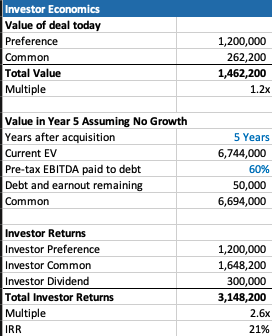
This is very much a “margin of safety” philosophy on things. Same with the calculation on how much you’ll receive in year 5 (after QSBS hits) assuming no growth in the business.
The only problem with each of these calculations is that they never play out in practice. Most companies don’t just stay the same, you’re either in a rising tide or you’re in trouble. And, you’re almost never going to sell in year 1, and definitely not for a slight premium to what it was bought for.
However, if your investment is worth 30% higher day one, and you can make a 20% IRR assuming nothing too crazy happens either way in the business, that’s not a bad place to start. Add in a strong searcher, decent market, some luck, and you’re off to the races.
Thoughts on searcher economics
A lot of this post has considered things from the investor perspective as my main quandary was related to how to create an EBITDA multiple that made sense for investors.
However, the point of this post is not to say searchers are misrepresenting or being unrealistic with their terms. In fact, I think it’s quite logical that self funded searchers capture the massive economic value that they do.
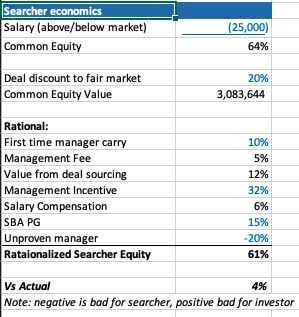
There are many reasons why self funded searchers deserve the lion share of the common equity.
First, they are providing a nice service of giving investors a positive expected value home to park their money with much lower correlation to the market than other asset classes ($1 mm EBITDA companies don’t see lots of multiple contraction/expansion throughout cycles).
Most money managers that fit that criteria are taking a 2/20, of course they also usually have a track record. So, I’ve used a 10% carry in my model, but stuck to 2% annual management fee.
The searcher spent a lot of time, and probably money, finding this company. That’s a lot of value, especially if it’s a below market price. They should be able to capture a lot of the value in finding a below market deal.
The searcher may be taking a below market salary, and needs to get comped like any CEO, with stock options. In my example model I have $1 mm of stock vesting over the hold period, as well as extra comp for taking a below market salary.
Searchers are also usually putting their financial standing at risk by taking a personal guarantee on the bank/SBA loan. This is really tough to put a number on, as is the last line in my framework where searchers are dinged for lack of experience. Like any good model, you need a few lines that you can fudge to make the math work 🙂
What you do think?
I’m shocked that I wrote all this. I was going to type a few paragraphs and a quick excel. However, putting this to paper has been a great exercise for me to sharpen my thinking.
Now I’d like you to help me further. Where do you think this should be changed in this framework? How do you think about things from the investor and/or searcher side?
Feel free to shoot me a note if you have thoughts (even just to tell me I’m being way too academic with this, which I actually agree with).
Lastly, a post like this is really a trap I’m putting on the internet to catch any like minded people in so that we can figure out ways to collaborate now or in the future. So, at the very least, connect with me on LinkedIn 🙂
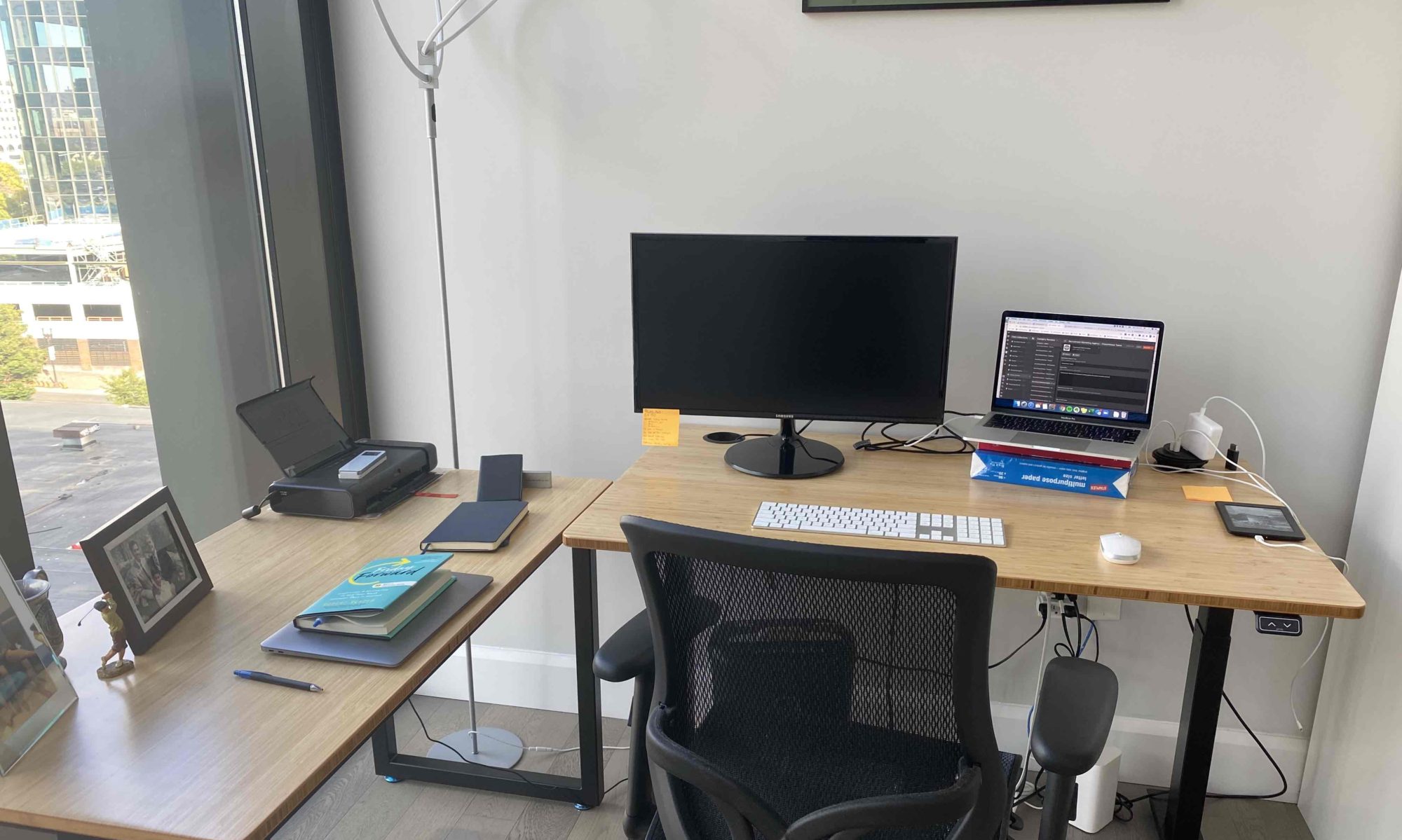
I visited various web pages however the audio quality for audio songs current at this site is in fact wonderful.
Thank you a bunch for sharing this with all people you actually know what you’re speaking about! Bookmarked. Kindly additionally talk over with my web site =). We may have a link exchange arrangement between us!
I know this if off topic but I’m looking into starting my own weblog and was curious what all is needed to get set up?
I’m assuming having a blog like yours would cost
a pretty penny? I’m not very internet savvy so I’m not 100% certain. Any suggestions or advice would be greatly
appreciated. Kudos
Thank you for some other informative web site. The place else may I get that kind of information written in such an ideal way?
I have a project that I am simply now working on, and I have
been on the glance out for such info.
I don’t even understand how I ended up here, however I believed this post was once good.
I don’t know who you’re however certainly you’re going to a
famous blogger in case you are not already. Cheers!
Hello there! I know this is somewhat off topic but I was wondering which blog platform are you using
for this site? I’m getting sick and tired of WordPress because I’ve had issues with
hackers and I’m looking at options for another platform.
I would be great if you could point me in the
direction of a good platform.
It’s in fact very complicated in this busy life to listen news on TV, thus
I just use world wide web for that reason, and take the most recent
information.
m health fairview and mag welding and j health care poor underserved
and q news mallanna and w health covid and d news agency.
Aw, this was an incredibly good post. Taking the
time and actual effort to make a really good article… but what can I say… I hesitate a lot and don’t manage to get anything done. https://www.theverge.com/users/rireh75718
Hello are using WordPress for your site platform?
I’m new to the blog world but I’m trying to get started and set up my
own. Do you require any coding expertise to make your own blog?
Any help would be really appreciated!
bookmarked!!, I like your blog!
Greetings! Very helpful advice within this post! It is the little changes
that produce the biggest changes. Thanks a lot for sharing!
magnificent publish, very informative. I’m wondering why the opposite specialists of this sector don’t understand this. You should proceed your writing. I am sure, you have a great readers’ base already!
I’m impressed, I must say. Seldom do I encounter a blog that’s both educative and
amusing, and let me tell you, you have hit the nail on the
head. The problem is something too few folks are speaking intelligently about.
I’m very happy I came across this in my search for something relating to this.
Hello! I could have sworn I’ve been to this
blog before but after browsing through some of the post I realized it’s
new to me. Anyhow, I’m definitely happy I found
it and I’ll be bookmarking and checking back
frequently!
First off I would like to say great blog!
I had a quick question that I’d like to ask if you do not mind.
I was curious to know how you center yourself and clear your head before
writing. I’ve had trouble clearing my thoughts in getting my ideas out there.
I truly do take pleasure in writing however it
just seems like the first 10 to 15 minutes are generally lost simply just trying to figure out how to begin. Any ideas
or hints? Kudos!
gambling rated site top
blackjack websites
online casino for mac paypal
Does your blog have a contact page? I’m having a tough time locating it but, I’d like to
shoot you an e-mail. I’ve got some suggestions for your
blog you might be interested in hearing. Either way,
great site and I look forward to seeing it develop over time.
You are so interesting! I do not believe I’ve truly read something like this before.
So great to discover someone with some original
thoughts on this issue. Really.. many thanks for starting
this up. This website is one thing that is needed on the web, someone with a bit of originality!
Simply wish to say your article is as astonishing. The clearness
for your post is just great and i could suppose you’re a professional on this subject.
Well along with your permission let me to clutch your RSS feed to
keep up to date with drawing close post. Thank you 1,000,000 and please carry on the
enjoyable work.
Thank you for the good writeup. It in fact was a amusement account it.
Look advanced to more added agreeable from you! By the way, how could we communicate?
I was suggested this web site by my cousin. I am not certain whether or not this post is written via him as
no one else recognize such designated approximately my problem.
You’re wonderful! Thanks!
Wow, this article is nice, my younger sister is analyzing these kinds of things, thus I am going to tell her.|
I’m not that much of a internet reader to be honest but your sites really nice,
keep it up! I’ll go ahead and bookmark your website to come back later on. Cheers
Hello there, just became alert to your blog through Google, and found that it is really informative.
I am going to watch out for brussels. I will appreciate if you continue this in future.
A lot of people will be benefited from your writing.
Cheers!
Write more, thats all I have to say. Literally, it seems as though you relied on the video to make your point.
You clearly know what youre talking about, why
waste your intelligence on just posting videos to your blog when you could be
giving us something informative to read?
Awesome! Its in fact remarkable paragraph, I have got much clear idea about from this paragraph.
I couldn’t refrain from commenting. Very well written!
Its such as you learn my thoughts! You seem to understand so much approximately this,
such as you wrote the book in it or something. I believe that you simply could
do with some percent to force the message house a bit, however
instead of that, that is excellent blog. A great read.
I will certainly be back.
I loved as much as you will receive carried
out right here. The sketch is attractive, your authored material stylish.
nonetheless, you command get bought an nervousness over that you wish be delivering the following.
unwell unquestionably come further formerly again as
exactly the same nearly a lot often inside case you shield this hike.
Remarkable! Its really remarkable paragraph, I have got much clear idea on the topic of from this article.
Can I simply just say what a comfort to discover somebody
who truly knows what they are discussing on the web.
You certainly know how to bring a problem to light
and make it important. More people have to read this and understand this side of the story.
It’s surprising you’re not more popular given that you definitely have the gift.
Quality posts is the key to be a focus for
the users to pay a visit the site, that’s what this web page is providing.
Heya! I know this is kind of off-topic however I needed to ask.
Does managing a well-established website such as yours take a lot of work?
I’m brand new to writing a blog however I do write in my diary
every day. I’d like to start a blog so I can share my experience and feelings online.
Please let me know if you have any kind of suggestions or tips for new aspiring bloggers.
Thankyou!
Thanks for sharing your thoughts. I really appreciate your efforts and I will be
waiting for your further write ups thanks once again.
Very good blog you have here but I was curious about if you knew of any community forums that cover the same
topics talked about here? I’d really like to be
a part of group where I can get feedback from other knowledgeable people that share the same interest.
If you have any suggestions, please let me know. Bless you!
Exceptional post but I was wondering if you could write a litte more on this subject?
I’d be very thankful if you could elaborate a little
bit further. Bless you!
Hello all, here every person is sharing these experience,
so it’s fastidious to read this web site, and I used to visit this
blog every day.
Very nice post. I just stumbled upon your blog and wanted to say that I’ve really enjoyed
browsing your blog posts. In any case I’ll be subscribing to your rss feed and
I hope you write again very soon!
Oh my goodness! Incredible article dude! Thanks, However I
am having issues with your RSS. I don’t understand why I cannot subscribe to it.
Is there anybody else having identical RSS problems?
Anyone who knows the answer can you kindly respond?
Thanks!!
each time i used to read smaller articles that as well clear their motive, and that is also
happening with this post which I am reading at this time.
Hello, Neat post. There is a problem together with your web site
in internet explorer, may test this? IE nonetheless is the marketplace leader and a huge component of folks will pass over your fantastic writing due to this problem.
I have been browsing online more than three hours today, yet I never found any interesting article like yours.
It’s pretty worth enough for me. In my opinion, if all site owners and
bloggers made good content as you did, the net will be a lot more useful than ever before. https://nbascorenow.com
What i do not understood is if truth be told how you’re no longer actually much more
smartly-liked than you may be now. You’re so intelligent.
You understand therefore significantly in terms of this subject, made me in my view consider it from a lot of numerous
angles. Its like women and men aren’t fascinated until it’s something to accomplish with Woman gaga!
Your personal stuffs excellent. At all times deal with it
up!
Thanks for sharing your info. I truly appreciate
your efforts and I will be waiting for your further post thanks
once again.
Howdy! Someone in my Myspace group shared this site with us so
I came to check it out. I’m definitely loving
the information. I’m book-marking and will be tweeting this
to my followers! Wonderful blog and amazing design and style.
Hi there! Do you know if they make any plugins to safeguard against hackers?
I’m kinda paranoid about losing everything I’ve worked hard on. Any suggestions?
Its not my first time to pay a quick visit this web page, i am visiting
this web page dailly and get good information from here every day.
Everything is very open with a precise explanation of the challenges.
It was definitely informative. Your site is extremely helpful.
Many thanks for sharing!
Thank you a bunch for sharing this with all of us you actually recognize what you’re speaking about!
Bookmarked. Please also consult with my website =).
We can have a hyperlink exchange arrangement between us